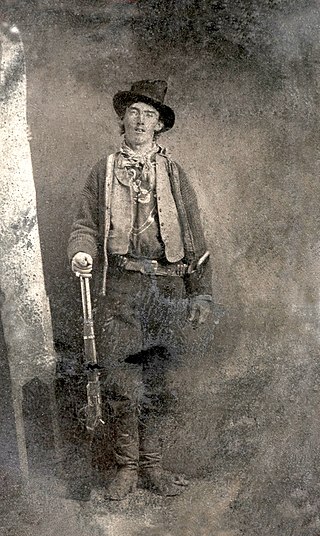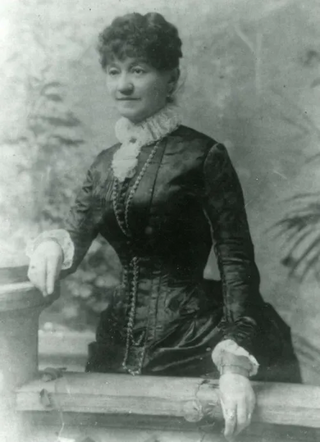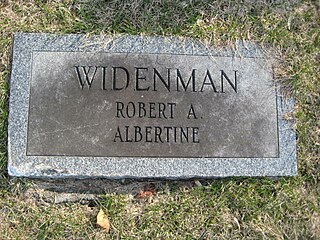Related Research Articles

Henry McCarty, alias William H. Bonney, better known as Billy the Kid, was an American outlaw and gunfighter of the Old West who is alleged to have killed 21 men before he was shot and killed at the age of 21. He is also known for his involvement in New Mexico's Lincoln County War, during which he allegedly committed three murders.

The Lincoln County War was an Old West conflict between rival factions which began in 1878 in Lincoln County, New Mexico Territory, the predecessor of the state of New Mexico, and continued until 1881. The feud became famous because of the participation of William H. Bonney. Other notable participants included Sheriff William J. Brady, cattle rancher John Chisum, lawyer and businessmen Alexander McSween, James Dolan and Lawrence Murphy.

Young Guns II is a 1990 American Western action film and a sequel to Young Guns (1988). It stars Emilio Estevez, Kiefer Sutherland, Lou Diamond Phillips, and Christian Slater, and features William Petersen as Pat Garrett. It was written by John Fusco and directed by Geoff Murphy.

Patrick Floyd Jarvis Garrett was an American Old West lawman, bartender and customs agent known for killing Billy the Kid. He was the sheriff of Lincoln County, New Mexico, as well as Doña Ana County, New Mexico.

Pat Garrett and Billy the Kid is a 1973 American revisionist Western film directed by Sam Peckinpah, written by Rudy Wurlitzer, and starring James Coburn, Kris Kristofferson, Richard Jaeckel, Katy Jurado, Chill Wills, Barry Sullivan, Jason Robards, Slim Pickens and Bob Dylan. The film is about an aging Pat Garrett (Coburn), hired as a lawman by a group of wealthy New Mexico cattle barons to bring down his old friend Billy the Kid (Kristofferson).

John Henry Tunstall was an English-born rancher and merchant in Lincoln County, New Mexico, United States. He competed with the Irish Catholic merchants, lawmen, and politicians who ran the town of Lincoln and the county. Tunstall, a member of the Republican Party, hoped to unseat the Irish and make a fortune as the county's new boss. He was the first man killed in the Lincoln County War, an economic and political conflict that resulted in armed warfare between rival gangs of cowboys and the ranchers, lawmen, and politicians who issued the orders.

John Simpson Chisum was a wealthy cattle baron in the American West in the mid-to-late 19th century. He was born in Hardeman County, Tennessee, and moved with his family to the Republic of Texas in 1837, later finding work as a building contractor. He also served as county clerk in Lamar County. He was of Scottish, English, and Welsh descent.
David Lawrence Anderson was a 19th-century American outlaw, better known under the alias Billy Wilson, who rode with Billy the Kid following the Lincoln County War. In his later years, he also served as a law enforcement officer and a U.S. customs inspector.
George W. Hindman was a 19th-century American cowboy and law enforcement officer serving as a deputy sheriff of Lincoln County, New Mexico, during the early months of the Lincoln County War.
The Battle of Lincoln, New Mexico, so-called Five-Day Battle or Five-Day Siege, was a five-day-long firefight between the Murphy-Dolan Faction and the Regulators that took place between July 15–19, 1878, in Lincoln, New Mexico. It was the largest armed battle of the Lincoln County War in the New Mexico Territory. The firefight was interrupted and suppressed by United States Cavalry led by Lt. Col. Nathan Dudley from Fort Stanton.
The Seven Rivers Warriors was an outlaw gang of the Old West known primarily due to its part in the Pecos War and the Lincoln County War.

White Oaks is a ghost town in Lincoln County, New Mexico, United States. Located on the outskirts of the Lincoln National Forest, it became a boomtown in 1879 following the discovery of gold and coal in the nearby Jicarilla Mountains.

Susan McSween was a prominent cattlewoman of the 19th century, once called the "Cattle Queen of New Mexico", and the widow of Alexander McSween, a leading factor in the Lincoln County War, who was shot and killed by members of the Murphy-Dolan faction.

The Authentic Life of Billy, the Kid, The Noted Desperado of the Southwest is a biography and partly first-hand account written by Pat Garrett, sheriff of Lincoln County, New Mexico, in collaboration with a ghostwriter, Marshall Ashmun "Ash" Upson. During the summer of 1881 in a small New Mexican village, Garrett shot and killed the notorious outlaw, William H. Bonney, better known as Billy the Kid. Due to the first publisher's inability to widely distribute this book beginning in 1882, it sold relatively few copies during Garrett's lifetime. By the time the fifth publisher purchased the copyright in 1954, this book had become a major reference for historians who have studied the Kid's brief life. The promotion and distribution of the fifth version of this book to libraries in the United States and Europe sent it into a sixth printing in 1965, and by 1976 it had reached its tenth printing. For a generation after Sheriff Garrett shot the Kid, his account was considered to be factual, but historians have since found in this book many embellishments and inconsistencies with other accounts of the life of Billy the Kid.

Robert A. Widenmann was a Deputy United States Marshal and associate of Billy the Kid during the Lincoln County War.

The Law vs. Billy the Kid is a 1954 American western film directed by William Castle and starring Scott Brady, Betta St. John and Paul Cavanagh. It was produced by Sam Katzman for distribution by Columbia Pictures.

The legend of Billy the Kid has acquired iconic status in American folklore, yet the outlaw himself, also known as William Bonney, had minimal impact on historical events in New Mexico Territory of the late 1800s. More has been written about Billy the Kid than any other gunslinger in the history of the American West, while hundreds of books, motion pictures, radio and television programs and even a ballet have been inspired by his legend.

Robert Ameredith B. "Pecos Bob" Olinger was a frontier lawman best known as the last victim of Billy the Kid and as a participant in the Lincoln County War.

The Kid is a 2019 American Western film directed by Vincent D'Onofrio, from a screenplay by Andrew Lanham. The film stars Ethan Hawke, Dane DeHaan, Jake Schur, Leila George, Chris Pratt, Adam Baldwin, and Vincent D'Onofrio.

Stinking Springs was a ranch and an overnight way station for cattle drivers and sheep herders located near the present site of Taiban, New Mexico. On 23 December 1880 sheriff Pat Garrett and his posse found Billy the Kid and the Regulators in a stone hut, where it began a shoot-out which killed Charlie Bowdre and captured Billy, Dave Rudabaugh, Tom Pickett and Billy Wilson. Only the foundation remains nowadays.
References
- 1 2 Reynolds 1994, p. 153.
- 1 2 Keleher 2007, p. 332.
- 1 2 Bartholomew, Ed Ellsworth (1958). The Biographical Album of Western Gunfighters: Containing More Than 1,000 Biographical Entries Together with Over Six Hundred Rare Photographs of the Most Famous Sheriffs, Outlaws, Marshalls, and Celebrated Personalities in the History of the Western Frontier. Frontier Press of Texas. p. 78.
- 1 2 3 Metz, Leon Claire (2002). The Encyclopedia of Lawmen, Outlaws, and Gunfighters. Infobase Publishing. p. 20. ISBN 9781438130217.
- 1 2 Haldane 2013, p. 44.
- ↑ "Deputy Sheriff James W. Bell". Officer Down Memorial Page . Retrieved 20 April 2024.
- ↑ U.S. Bureau of the Census, United States Census of 1880, White Oaks, Lincoln County, New Mexico
- 1 2 Williams, Oscar Waldo (1966). Myres, Samuel Dale (ed.). Pioneer Surveyor, Frontier Lawyer: The Personal Narrative of O.W. Williams, 1877-1902. Texas Western College Press. p. 89.
- ↑ Gillett, James B. (10 September 2021). Six Years With the Texas Rangers: 1875 to 1881. e-artnow. pp. 53, 56–57.
- ↑ Reynolds 1994, p. 158.
- ↑ Reynolds 1994, p. 159.
- ↑ Reynolds 1994, p. 154.
- 1 2 3 Haldane 2013, p. 45.
- ↑ Reynolds 1994, p. 160.
- ↑ White Oaks Golden Era, March 10, 1881
- 1 2 "Happenings in White Oaks Twenty Years Ago". White Oaks Eagle. 3 January 1901. p. 1 – via Newspapers.com.
- ↑ Nolan, Frederick (16 February 2015). West of Billy the Kid. University of Oklahoma Press. pp. 233–235. ISBN 9780806173689.
- ↑ Garrett & Nolan 2000, p. 115-17.
- 1 2 3 4 Haldane 2013, p. 46.
- ↑ White Oaks Golden Era, February 3, 1881,
- ↑ Garrett & Nolan 2000, p. 128.
- ↑ Keleher 2007, p. 296.
- ↑ Lavash, Donald R. (1990). Wilson & The Kid. Creative Publishing Company. p. 60. ISBN 9780932702494.
- ↑ Las Vegas Daily Optic, January 21, 1881 and May 3, 1881
- ↑ Reynolds 1994, p. 161.
- ↑ Lincoln County Historical Society, "From Mr. G. Gauss", 1-5
- 1 2 Haldane 2013, p. 47.
- ↑ Klasner, Lily; Chisum, John Simpson (1972). My Girlhood among Outlaws. University of Arizona Press. p. 189. ISBN 9780816503544.
- ↑ White Oaks Golden Era, May 5, 1881
- ↑ "Happenings in White Oaks Twenty Years Ago". White Oaks Eagle. 14 February 1901. p. 4 – via Newspapers.com.